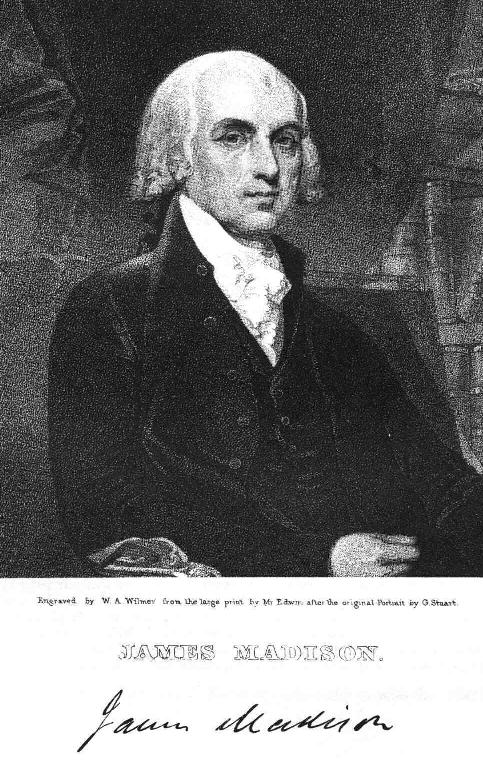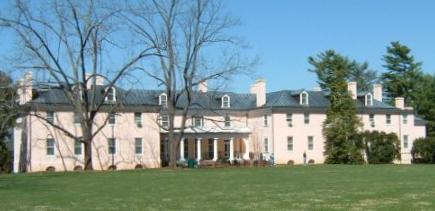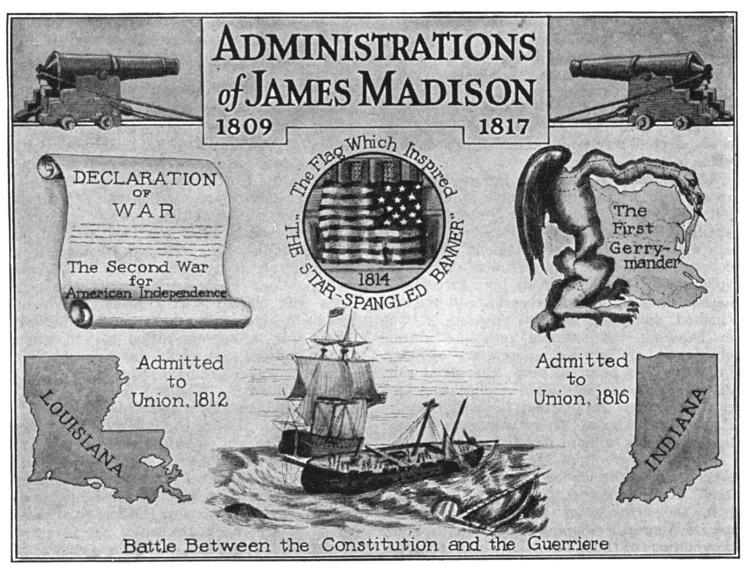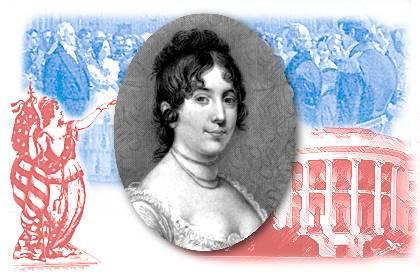| |
Home
Famous and Fascinating Women in History
Frontiersmen and Women
The World's Greatest Composers
Famous Women Spies
Great Authors of the World
Generals and other Noteworthy People
from the Civil War
The Presidents of the United States
The First Ladies of the United States
Homes and Monuments of and to
Famous People
Historical People and Events by Month for Each Day of the Year!
Famous Figures in Black History
The Calvert Family and the Lords Baltimore
Understanding the American Revolution and its People
Everything Beatles!
Everything Maryland! |
| |
|
 
|
 |  | 
James Madison and Montpelier
By John T. Marck

Montpelier
James Madison's father Ambrose,
purchased 4,675 acres of land in 1723 on the Virginia frontier in what
would later become Orange County. It would be on this land that
he desired to start a tobacco plantation, and to accomplish this he
used a small number of slaves to handle the tedious process of
clearing the land, building a house and constructing the other
necessary outbuildings. In 1732, Ambrose and his wife Frances Taylor
Madison, along with their children moved into their new home, which
they called Mount Pleasant. In less than 6 months thereafter,
Ambrose died, the victim of poisoning. It has been said by historian
Ann Miller that Ambrose fell ill probably in early summer, from
poisoning, but this poison did not kill him directly, but rather
caused damage to his system, which doomed him to a slow death that
took several months, dying on August 27. It was discovered that three
slaves conspired to poison Ambrose, who later were convicted of
murder, the first such crime to occur in the region.
Upon her husband's death, Frances
assumed the duties of the plantation until their oldest and only son
James was able to take over in 1741. Colonel Madison, as he was known,
grew into an excellent farmer and businessman, and was able to show a
very good profit from the farming. In 1749 James married Nelly Conway,
who in 1751 gave birth to the first of 12 children, a son, James
Madison, Jr., who would become the future president. This birth took
place at the home of her mother in Port Conway, Virginia. Four years
later in 1755, the Madison family began building a new home which took
five years to complete, which became Montpelier.

In 1760 when James Jr., was nine,
they moved into this new home that was originally a simple eight-room
brick house. Although the exact date of the move in not known,
James Jr., wrote in his memoirs that he remembered moving items and
light pieces of furniture to this new house at the age of nine. In
time this house would undergo many changes. The first significant
change came in 1797 when James Jr., returned from Philadelphia with
his new bride, Dolley. To accommodate them, a thirty-foot addition was
added as well as a second front door, making the house a duplex.
Twelve years passed before
additional construction began in 1809. This consisted of adding
two wings on each side of the house and the original dividing wall in
the middle removed. A central front door was added and when James
completed remodeling Montpelier, it had a total of 30 rooms.

It would not be until 1801 that
James Jr. inherited Montpelier and it took until 1817 for James and
Dolley to move and live there exclusively. Although it took many
years before James Jr. would inherit Montpelier, this delay was merely
a result of the natural course of events, rather than any problems
between himself and his father.
James Madison
As mentioned earlier, James was
born in Port Conway, Virginia on March 16, 1751, the oldest of twelve
children, and grew up on the family's plantation, Montpelier.
Madison's formal schooling began in
1762 at the age of eleven upon attending a school that was operated by
a Presbyterian minister named Daniel Robertson. This school was
located in King and Queen County, and was so far from his home that he
could not travel the distance daily. Therefore, James lived at
the school until the age of 16, and then returned to Montpelier where
Thomas Martin tutored him until the age of 18. In 1769, James began
his education at the College of New Jersey, which today is known as
Princeton University, where he graduated in 1771.
Madison's Early
Political Life
Three years after graduation,
Madison began a political career that would last 41 years, beginning
in December 1774, when he was appointed to the Orange County Committee
of Safety. In 1776, Madison was elected to the Virginia
Convention in Williamsburg that drafted the state's
first constitution. In the years that followed, James served as a
delegate to the Virginia House of Delegates, and was elected to the
Second Continental Congress as well as served as a member of the
United States House of Representatives. By the spring of 1787, Madison
traveled to Philadelphia where he attended the Constitutional
Convention. It was during this time that Madison drafted the
United States Constitution, some of his most brilliant work, earning
him the title at the age of 36 of Father
of the Constitution.

James & Dolley
In 1794, during the spring, James
met a Quaker widow named Dolley Payne Todd. That summer their
courtship began, which did not last long, resulting in their marriage
at the home of Dolley's sister on September 15, 1794. Although
they were married for 41 years, their marriage did not produce any
children. However, Dolley had two children from her first
marriage, of whom a son, John Payne Todd was raised as Madison's son.
Dolley Payne Todd Madison was born
on May 20, 1768 in Guilford County, North Carolina. At the age of one,
her family moved to Hanover County, Virginia where they lived until
1783 when they moved to Philadelphia. In 1790, Dolley married a
fellow Quaker gentleman named John Todd, Jr., with whom two children
were born; John Payne Todd and William Temple Todd. In 1793, during
the yellow fever epidemic, Dolley's husband John, his parents and
their infant son William all perished. About one year following her
husband's death, a friend, the legendary Aaron Burr introduced her to
the dashing James Madison.
The Madison's
and Washington D.C.
Under Thomas Jefferson, his
longtime friend, Madison was appointed Secretary of State resulting in
James and Dolley leaving Montpelier to live in Washington.
Unknown to them at this time, this move, would keep them in Washington
for the next 16 years. Madison would serve two terms as
Secretary of State in Jefferson's administration, followed by his
election as the fourth President of the United States, a position he
held for eight years. While serving as President, the War of 1812
began with Great Britain, and in 1814 British soldiers invaded
Washington and burned The White House, resulting in the president and
first lady making a narrow escape.
Before her husband would become
president, while he was Secretary of State, Dolley at times served as
President's Jefferson's hostess in the White House, which gave her
some prior experience of what was to come.
At her husband's inauguration in
1809, Dolley began refurbishing The White House, turning it into a
comfortable place for entertaining their guests. It seemed that Dolley
was a natural entertainer, so much so she became legendary in her
hospitality that welcomed many guests, and even made her husband's
political rivals feel at home. During the War of 1812, Dolley
and one of her servants is credited with saving the Gilbert Stuart
portrait of George Washington, removing it before the British burned
The White House.
Dolley Madison's
Firsts

During the Madison's 16 years in
Washington and at The White House, she is credited with several events
that were firsts.
Dolley was the first to serve ice
cream in The White House, which occurred during Jefferson's
presidency; She initiated the first Easter Egg Roll on the Capital
Lawn; She was present when the cornerstone was laid for the Washington
Monument; She sent the first telegraph message, and at her funeral in
1849, Zachary Taylor used the phrase "First
Lady "
to describe her, a term which has since been used to describe the
president's wife.
The Madison's in
Retirement
In 1817, when his second
term as president ended, James and Dolley returned to Montpelier.
James stayed active in retirement, founding the American Colonization
Society in 1819 that was dedicated to freeing slaves and transporting
them to the West Coast of Africa. Additionally Madison served on the
board of visitors at the University of Virginia. In 1829 at the
age of 79, James came out of retirement to attend the Virginia
Constitutional Convention.
Madison enjoyed writing, but in his
later years suffered from arthritis and was unable to do so, resulting
in Dolley spending a great deal of her time assisting her husband,
writing the letters he could not following his dictation.
On June 28, 1836, James Madison
died at Montpelier at the age of 85, and is buried in the Family
Cemetery on the grounds. Upon his death, Dolley left
Montpelier and returned to live in Washington, D.C.
Montpelier Today
Over the years since the Madison's
resided there, Montpelier has had several owners, the last being
Marion DuPont Scott who died in 1983 and left the house and grounds to
the National Trust for Historic Preservation. Montpelier opened
its doors to the public in 1987 and in 2000; the Montpelier Foundation
became the steward of the property.
During the DuPont ownership,
various additions and buildings were added between 1901 and 1917.
The main house doubled in size and was remodeled early in the DuPont
ownership, primarily between 1901 and 1903. Between c.1928 and 1937,
Marion DuPont Scott, assisted by her friend Carroll Bassett and her
private pilot Edward Conklin, masterminded the renovation of the
Montpelier "Red Room" in the Art Moderne style. Charlottesville
architect Milton Grigg drew the design for the glass and mirrored
mantel in the Red Room. Most of the later repairs to the Montpelier
house were done by the Charlottesville firm of Johnson, Craven and
Gibson as consulting architects, using McCormick Construction,
Charlottesville, as general contractor.
Today Montpelier includes more than
2,700 acres of rolling pastures, gardens, and timber. The estate has
evolved from the plantation that was home to three generations of
Madison's, to the estate created under the DuPont ownership. Visitors
can enjoy a two-acre formal garden, a landscape that includes a
mixture of trees planted during the Madison era as well as ornamentals
planted in the 20th Century. Montpelier is also home to more than 200
acres of old growth timber, known today as the James Madison Landmark
Forest.
Visits to Montpelier begin and end
at the Visitor Center and Museum Gift Shop. Here you can purchase your
admission tickets and a wide variety of souvenirs and gifts.
Quick Biographical Facts
James
Madison
4th President
Term- March 4,
1809 to March 4, 1817
Democratic-Republican Party

Birth:
Port Conway, Virginia, March 16, 1751
Ancestry:
English
Marriage:
"Harewood" Jefferson County, Virginia, September 15, 1794 to Dorothea
(Dolly) Payne Todd who was born in Guilford County, North Carolina,
May 20, 1768. Dolly died in Washington D.C., July 12, 1849, and is
buried at "Montpelier," Virginia.
Children:
None; Raised a son John Payne Todd from Dolley's first marriage.
Home:
"Montpelier"
Education:
Received early education at Donald Robertson's school in Virginia and
from private tutors; Awarded B.A. from the College of New Jersey
(Princeton 1771); one-year postgraduate study at Princeton.
Religion:
Episcopalian
Occupation before Presidency:
Member of Orange County Committee of Safety; Delegate to the Virginia
Convention; Member of Virginia Legislature; Member of Virginia
Executive Council; Delegate to Continental Congress; Delegate to
Annapolis Convention; Delegate to Constitutional Convention; Member of
the Virginia Ratification Convention; U.S. Congressman; Secretary of
State.
Age at Inauguration:
57
First Administration:
Vice-President: George Clinton of New York, Inauguration March 4,
1809, House of Representatives, Washington D.C.
Second Administration:
Vice-President: Elbridge Gerry of Massachusetts, Inauguration March 4,
1813, House of Representatives, Washington D.C.
Occupation after Presidency:
Retired
Death:
"Montpelier", Virginia, June 28, 1836.
Cause of Death:
Debility at age 85.
Place of Burial:
"Montpelier", Virginia.
Interesting Fact:
During Madison's Presidency,
in the War of 1812, Francis Scott Key watched the British bombard Fort
McHenry, Baltimore that inspired his Star-Spangled Banner.
Although the song was popular, it was not made the official national
anthem until 1931.
Copyright © by John T. Marck.
Grateful appreciation and informational assistance from the Montpelier
Foundation. Information in part, as well as "Montpelier
Today@
noted in quotations supplied by the Montpelier Foundation. Quick
Biographical Facts from "The Presidents of the United States,@
by John T. Marck.
A Splendid Time Is Guaranteed For All
| | |
| |

